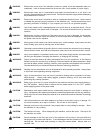
AMERICAN SANDERS TECHNOLOGY -American 12 Floor Sander Operator's Manual
Page 11
Figure 5
To operate the machine follow this procedure:
1. Install the operator's belt as follows:
a. Position the operator's belt around waist.
b. Cross the straps at the waist. See figure 5.
c. Slide the belt loop end over the handle on the
control lever side. Adjust the length as
needed.
d. Wrap the remaining strap around the oppo-
site side of the handle and hold it in place
with your hand.
WARNING: Should quick release of the ma-
chine be necessary, serious op-
erator injury could occur if the
operator has tied the loose end
of the operator's belt strap to the
machine. Always position the
strap so that you can let go and
get away quick in case of bag
fire or explosion.
2. Put the On/Off switch into the "ON" position.
DANGER: Serious damage can occur to
the floor surface if the machine
is not in motion while the con-
tact wheel is running on the floor
surface. To prevent damage to
the surface, make sure the ma-
chine is always moving when
the contact wheel is in contact
with the floor.
3. Work right to left. For each forward pass, move
the machine 4" over the pass you have just
finished. Retrace your reverse path without
overlapping. See figure 6.
4. Feather-cut in by easing the contact wheel down
onto the surface with the control lever while the
sander is in motion.
5. When contact wheel is fully engaged with the
surface, gradually adjust your pace for adequate
finish removal. Keep sander in motion while the
contact wheel is engaged with the surface or
dwell marks will occur.
6. Move the machine in the direction of the grain in
the wood whenever it is possible. Sand the
surface at a constant pace.
7. Gradually feather-cut out at the termination point
(the end of your pass) by easing the contact
wheel up with the control lever. Stagger the
termination points for a better blend when
edging.
8. Empty dust bag whenever it is 1/3 full. Never
leave a dust bag unattended with sanding dust in
it. Sanding dust can spontaneously ignite and
cause a fire or explosion. Empty dust into a
metal container located outside of the building.


















